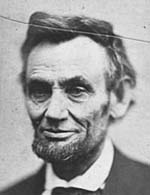Errors
Abraham Lincoln
Mistaking Image for IndividualTraditions extend themselves, sometimes by literal preservation, but much more often by growing to fit the needs of those who receive those traditions. This is true of ritual (see Buckingham Palace), and it is also true of individuals.
In their lifetime, and especially after their death, individuals who survive at all in the memory of a culture do so by being processed into images which are more agreeable to the mind of that culture than the modest reality of the actual person. We must always remember to distinguish between the man (who, in most cases, actually existed) and the image (which is the result of a cultural reshaping process). Images may be multiple, since culture itself has many different corners, which may want different things from the past. If the persona of Yi Yin is different in different chapters of the Mencius text, that is because those different chapters come out of situations that needed to have Yi Yin exemplify of different qualities. Cultures on the whole do not make up new names for new qualities. They reinvent well-known and acceptable old names.
The mythologizing of persons is more easily understood from modern examples, where we can watch the process of substitution as it happens. For examples of how later society impinges on personages to create historical myths, and for examples of how the historical study of the myth process can be responsibly carried out, one could do worse than check out the American history field.
Not all myths are celebratory; some have the intention of blackening their subject. Lincoln is a good example of myths both pro and con, and we have named this error after him. The Lincoln Error is accepting a myth in place of a person. It should be added that there is not always a person in back of the myth. Some cultural myths are so insistently ready to be born that they invent a person for the purpose.
Not only are myths of persons sometimes intentionally engineered (in the case of Lee, Lincoln's great rival, by committees appointed for the purpose), the persons themselves may do the engineering. They will often act during their lifetimes so as to convey a certain image of themselves (one thing they taught in the Analects was how to project an image of sufficient gravity). These skills of presentation have become very highly developed at the present time, creating new layers of myth for the historian and journalist to penetrate. That is just the way things are. The historian must learn to deal with it, just as the physician must learn to deal with new and highly resistant "hospital" strains of bacteria.
The following provide further reading on some of the points touched on above:
- Lloyd Lewis. Myths After Lincoln. Harcourt 1929
- Thomas Connelly. The Marble Man [Robert E Lee]. Louisiana 1977
- Frank Anderson. The Mystery of a "Public Man." Minnesota 1948.
15 June 2004 / Contact The Project / Exit to History Page

